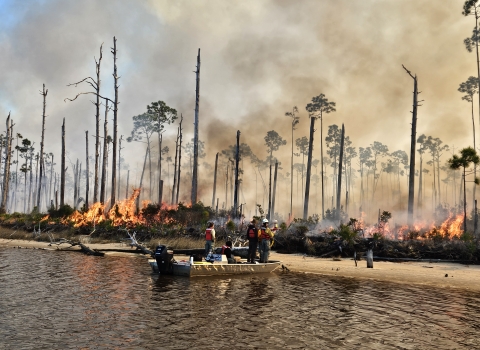These survey windows were determined using information from species recovery plans, field observations, herbaria specimens, and NC Natural Heritage Program information. If suitable habitat for species is present in the proposed impact area, the U.S. Fish and Wildlife Service will likely request species surveys, conducted by a qualified biologist, during the optimal survey window. Projects are reviewed on a case-by-case basis and you are encouraged to contact a Section 7 Section 7
Section 7 Consultation
The Endangered Species Act (ESA) directs all Federal agencies to work to conserve endangered and threatened species and to use their authorities to further the purposes of the Act. Section 7 of the Act, called "Interagency Cooperation," is the mechanism by which Federal agencies ensure the actions they take, including those they fund or authorize, do not jeopardize the existence of any listed species.
Learn more about Section 7 coordinator early in the project planning process. To discuss your project and survey recommendations with a Section 7 coordinator, please contact the Asheville Field Office at 828/258 3939 or the Raleigh Field Office at 919/856 4520.
| SCIENTIFIC NAME | COMMON NAME | STATUS | SURVEY WINDOW | YEARS SURVEY IS VALID |
| Aeschynomene virginica | sensitive joint-vetch | T | July – October | 1 |
| Amaranthus pumilus | seabeach amaranth | T | July - October (or before first tropical storm that causes overwash) | 1 |
| Amorpha georgiana var. georgiana | Georgia lead-plant | ARS | late April – October | 2 |
| Cardamine micranthera | small-anthered bittercress | E | April - May | 1 |
| Carex impressinervia | impressed-nerved sedge | ARS | April - May | 2 |
| Carex lutea | golden sedge | E | mid April - mid June | 2 |
| Dionaea muscipula | Venus flytrap | ARS | late May – June | 2 |
| Echinacea laevigata | smooth coneflower | T | late May – October | 2 |
| Fimbristylis perpusilla | Harper’s fimbristylis | ARS | July – September | 2 |
| Geum radiatum | spreading avens | E | June – September | 2 |
| Gymnoderma lineare | rock gnome lichen | E | year round | 2 |
| Hedyotis purpurea var. montana | Roan Mountain bluet | E | June – July | 2 |
| Helianthus schweinitzii | Schweinitz's sunflower | E | late August – October | 2 |
| Helonias bullata | swamp pink | T | April – May | 2 |
| Hexastylis naniflora | dwarf-flowered heartleaf | T | March – May | 2 |
| Hudsonia montana | mountain golden heather | T | late May - early June | 2 |
| Isoetes microvela | thin-wall quillwort | ARS | April – July | 1 |
| Isotria medeoloides | small whorled pogonia | T | mid May - early July | 1 |
| Liatris helleri | Heller's blazing star | T | July – September | 2 |
| Lindera melissifolia | pondberry | E | February – March; September - October | 2 |
| Lindera subcoriacea | bog spicebush | ARS | March - August | 2 |
| Lobelia boykinii | Boykin’s Lobelia | ARS | May – July | 2 |
| Ludwigia ravenii | Raven’s seedbox | ARS | June - October | 2 |
| Lysimachia asperulaefolia | rough-leaved loosestrife | E | mid May – September | 2 |
| Macbridea caroliniana | Carolina birds-in-a-nest | ARS | July – November | 2 |
| Minuartia godfreyi | Godfrey’s stitchwort | ARS | April – June | 2 |
| Oxypolis canbyi | Canby's dropwort | E | mid July – September | 2 |
| Platanthera integrilabia | white fringeless orchid | T | mid July - late August | 2 |
| Ptilimnium nodosum | harperella | E | July – early September (during low water) | 1 |
| Rhus michauxii | Michaux's sumac | E | May – October | 2 |
| Rhynchospora crinipes | hairy-peduncled beakrush | ARS | July – September | 2 |
| Rudbeckia heliopsidis | sun-facing coneflower | ARS | July – September | 2 |
| Sagittaria fasciculata | bunched arrowhead | E | mid May – July | 2 |
| Sarracenia oreophila | green pitcher-plant | E | late April – October | 2 |
| Sarracenia purpurea var. montana | mountain purple pitcher-plant | ARS | April – October | 2 |
| Sarracenia rubra ssp. jonesii | mountain sweet pitcher-plant | E | April – October | 2 |
| Schwalbea americana | American chaffseed | E | May - August (1-2 months after a fire) | 2 |
| Sisyrinchium dichotomum | white irisette | E | late May – July | 2 |
| Solidago plumosa | Yadkin River goldenrod | CCA | September – October | 2 |
| Solidago spithamaea | Blue Ridge goldenrod | T | July – September | 2 |
| Symphyotrichum georgianum | Georgia aster | CCA | October - mid November | 2 |
| Spiraea virginiana | Virginia spiraea | T | May - early July | 2 |
| Sporobolus teretifolius | wire-leaved dropseed | ARS | July – September (following fire) | 2 |
| Thalictrum cooleyi | Cooley's meadowrue | E | mid June - early July | 2 |
| Tsuga caroliniana | Carolina hemlock | ARS | year round | 2 |





